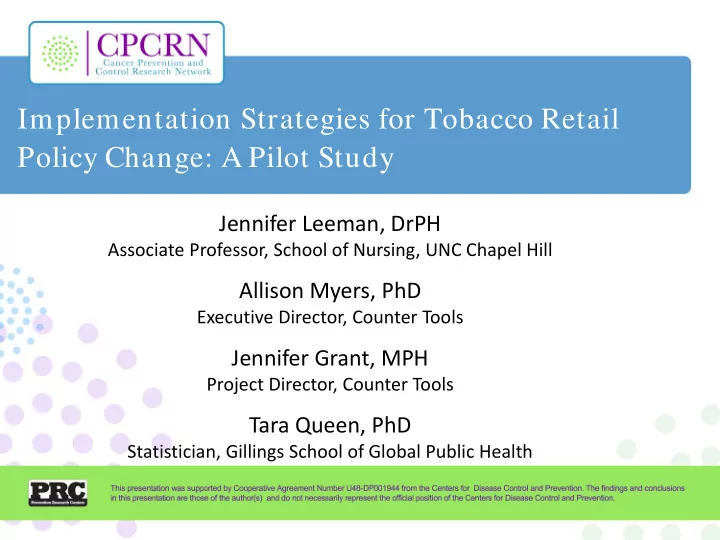

Implementation Strategies for Tobacco Retail Policy Change: A Pilot Study Jennifer Leeman, DrPH Associate Professor, School of Nursing, UNC Chapel Hill Allison Myers, PhD Executive Director, Counter Tools Jennifer Grant, MPH Project Director, Counter Tools Tara Queen, PhD Statistician, Gillings School of Global Public Health
Presenter Disclosures The following personal, professional, or financial relationships with commercial interests relevant to this presentation existed during the past 12 months: Jennifer Leeman, DrPH “No relationships to disclose” Allison Myers, PhD, MPH and Jennifer Grant, MPH are full-time employees of Counter Tools, a 501c3 non-profit organization. In her role as co-inventor, Dr. Myers also receives royalties from distribution of Counter Tools’ software tools (Store Audit Center and Store Mapper), which are owned by UNC-CH.
Background • US tobacco industry spends $8.2 billion annually on marketing at the point-of-sale (POS) • Evidence-based policy interventions (EBPIs) are available to counter POS tobacco marketing • Yet, little is known about implementation strategies’ effects on EBPI adoption and enactment
Nationwide, Community Partnerships are Promoting POS Tobacco EBPI Laws, ordinances, or resolutions to • Regulate tobacco advertising, price, price promotion, and placement • Reduce retailer density • Prohibit tobacco retailers near schools and other youth-oriented facilities • Restrict sales of flavored products
To Promote EBPIs - Activate Three Streams PROBLEM STREAM POLICY POLICY STREAM POLICY OUTPUT WINDOW POLITICS STREAM Kingdon's Multiple Stream s Theory of Policy Change
Five “Processes” Partnerships Use to Active Kingdon’s three streams • Document local problem • Formulate policy solutions • Engage strategic partners • Raise awareness of problems & solutions • Persuade decision makers Kingdon's Multiple Stream s Theory of Policy Change
Counter Tools provides implementation strategies to support policy change processes • Tools to collect local data (store audit and mapper) • Guidance on evidence-based policy solutions (EBPI) • Toolkits of activities to engage partners • Photo galleries and communication templates to raise awareness and persuade decision makers • Training and technical assistance
Counter Tools Provides Implementation Strategies to Community Partnerships in 18 States Partnering with Counter Tools offers an opportunity to study effects of im plem entation strategies
Our Conceptual Framework
Pilot Study of Counter Tool’s Impact Design : Quasi-experimental, pre-test/post-test Sample : 30 community partnership coordinators in one southern state. Measures : • Self-efficacy to coordinate EBPI adoption process • Policy Adoption Process Completion • Policies proposed and enacted
Self-Efficacy Measure – 36 Items (Likert) Five constructs 1. Engage partners 2. Select/adapt EBPIs 3. Create action plan 4. Implement action plan From earlier version of measure (α= .81 to .91) (Leeman et al., 2016) 5. Document local problem (new)
Policy Adoption Processes Completion Measure • Modeled on Stages of Implementation Completion Measure (Chamberlain, Brown, & Saldana, 2001) • Formative work to identify 16 activities across each of 5 policy adoption processes • Structured phone interviews at 6 and 12 months
Policies Proposed and Enacted Measure • 25 policy options categorized in 6 domains • 5 response options: – No formal activities (0) – Planning/advocating (1) – Policy proposed (2) – Policy enacted (3) – Policy implemented (4) Luke et al. 2016
Findings – Self-Efficacy • 26 coordinators completed baseline and 12 month surveys (87% response rate) • Self-efficacy increased significantly for all but two of 36 items • Items with lowest self-efficacy at 12 months • Work with my team to develop a POS action plan • Specify measurable objectives for POS efforts • Engage community members in POS efforts • Earn media coverage to raise awareness of POS
Findings –Policy Adoption Process Completion Proportion of Activities Completed 100 90 80 70 60 50 40 30 20 10 0 Document Formulate Engage Raise Persuade Problem Solution Partners Awareness 87% (6 - months) and 100% (12 -months) response rates
Examples of Findings –Policy Adoption Process Completion Document problems (4 items) • • Completed store audits = 97% Analyzed local data = 63% • • Formulate evidence-informed solutions (4 items) Assess local policy = 80% completed • • Draft policy proposal = 3% completed • Raise awareness (4 items) • Participate in/hold events = 87% completed Create/distribute press release = 13% completed •
Types of EBPIs planning/ advocating Policy domain T1 T2 p % of teams % of teams (n) (n) Licensing & Tobacco 25.0% (6) 37.5% (9) 0.375 Retailer Density POS Advertising 33.3% (8) 41.7% (10) 0.727 Product Placement 58.3% (14) 58.3% (14) 1.000 Health Warnings 16.7% (4) 29.2% (7) 0.508 Non-tax Approaches 4.2% (1) 29.2% (7) 0.070 ‘Other’ POS policies 45.8% (11) 45.8% (11) 1.000
Next Steps Measures development 1. Continue to develop Policy Adoption Process Completion Measure 2. Assess measures’ validity/reliability with larger sample 3. Assess measures’ predictive validity over longer time frame – Policy formulated – Policy proposed – Policy enacted Further Test/Refine Counter Tool’s Implementation Strategies
Long-term goals • Develop pragmatic, broadly applicable measures of policy implementation strategy effectiveness • Advance understanding of mechanisms to explain how, why, and when strategies work • Test and strengthen Counter Tools implementation strategies
Recommend
More recommend